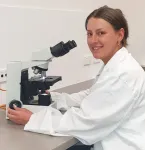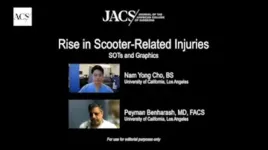(Press-News.org) Researchers from University of Oxford, Arizona State University, and University of Iowa published a new Journal of Marketing study that examines how paying doctors to visit rural areas is a cost-effective way to provide reasonable access and effective care to most rural communities.
The study, forthcoming in the Journal of Marketing, is titled “Bringing the Doctor to the Patients: Cardiology Outreach to Rural Areas” and is authored by J. Jason Bell, Sanghak Lee, and Thomas S. Gruca.
Rural health care is in crisis.
Between 2010 and 2015, the death rate from coronary heart disease was significantly higher in rural areas (118.2 per million) than in urban areas (106.2 per million). The shortage of cardiologists is an especially serious issue facing over 60 million rural Americans who suffer from higher levels of heart disease, hypertension, and stroke. Reflecting concern over rising death rates for heart disease and stroke in rural areas, the American Heart Association (AHA) and American Stroke Association (ASA) issued a “Call to Action” in 2020 to address the rising inequities in cardiovascular health of rural Americans.
Since most rural communities are too small to support a full-time cardiologist, outreach clinics help increase access to cardiologists for under-served rural patients. Bringing cardiologists to the local community reduces the need for patients to travel inconvenient distances and can lead to more timely diagnoses and treatment, resulting in better patient outcomes. However, it is important for hospitals, policymakers, and insurance providers to understand outreach decisions and how they may be impacted by the coming cardiologist shortage.
This new study estimates the financial costs of mitigating cardiologist shortages by studying outreach patterns over 30 years in the state of Iowa. While rural areas are underserved by cardiologists, urban areas seem to be in a state of oversupply. As per 2019 data for Iowa, the number of cardiologists per 100,000 people is 10.6 in urban counties compared to 1.5 in rural counties and 6.5 nationwide. The level of competition for patients in urban locations provides further motivation for engaging in rural outreach.
Iowa has fewer than 200 cardiologists, almost all of whom live in urban areas—and their number is expected to drop by 10% in the coming years. To make up for the lack of rural presence in Iowa, many practices have developed a strong network of visiting consultant clinics where physicians in many specialties, including cardiology, make periodic visits from urban to rural areas. The networks provide reasonable access and effective care to most rural communities.
An Australian Model
While the outreach clinic model has been the most successful in plugging holes in rural cardiology access, it still has weaknesses. Physicians who participate in the program are unable to see patients while they are driving to the outreach clinic. This “windshield time” can last as long as two to three hours in Iowa and includes not just lost opportunities to see patients, but also mileage and other vehicle expenses. The opportunity costs are significant enough that only about half of Iowa’s cardiologists participate in an outreach clinic.
In Australia, which has an even greater rural health care crisis than the U.S., the government’s Rural Health Outreach Fund subsidizes qualifying specialists to motivate them to practice in rural areas. As Bell explains, “our study finds that if a payment program were adopted in Iowa to subsidize physicians for their windshield time, the payments would cost about $405,000 a year to maintain the current level of cardiology care in rural areas, even after the anticipated decline in numbers.”
The study also explores other options.
The suggestion to recruit foreign doctors to practice in rural areas has met with some success for primary care physicians, where the bulk of the funding is targeted. For such a program to be more cost effective than the public subsidy, it would have to attract five cardiologists who would work for $81,000 or less a year, a highly unlikely outcome. That would provide far less coverage than the network of outreach clinics for the same cost.
Increased use of telehealth has also been proposed, but patients have been reluctant to use it for complicated health concerns. Furthermore, there are issues regarding reimbursement for cardiac telehealth consultations and lack of reliable, high-speed internet access in many rural areas.
The study looks only at cardiology, but the findings suggest that similar public subsidies would be an effective way to at least maintain health care coverage in rural areas in other specialties. “While we have generally been reluctant to suggest the government pay providers to practice in certain locations, we have few other feasible options to provide equitable access to necessary health care to some 60 million rural Americans,” says Lee.
Future research needs to move beyond the usual focus on merely improving provider outcomes to advancing our understanding of the implications for patients. Gruca states that “our novel way of viewing the problem of patient access shows how it is influenced by the competitive marketing decisions individual providers make. We expect that focusing on provider behavior and patient outcomes will enable marketing scholars to provide valuable insights into other important and complicated problems in health care.”
Full article and author contact information available at: https://doi.org/10.1177/00222429231207830
About the Journal of Marketing
The Journal of Marketing develops and disseminates knowledge about real-world marketing questions useful to scholars, educators, managers, policy makers, consumers, and other societal stakeholders around the world. Published by the American Marketing Association since its founding in 1936, JM has played a significant role in shaping the content and boundaries of the marketing discipline. Shrihari (Hari) Sridhar (Joe Foster ’56 Chair in Business Leadership, Professor of Marketing at Mays Business School, Texas A&M University) serves as the current Editor in Chief.
https://www.ama.org/jm
About the American Marketing Association (AMA)
As the largest chapter-based marketing association in the world, the AMA is trusted by marketing and sales professionals to help them discover what is coming next in the industry. The AMA has a community of local chapters in more than 70 cities and 350 college campuses throughout North America. The AMA is home to award-winning content, PCM® professional certification, premiere academic journals, and industry-leading training events and conferences.
https://www.ama.org
END
The secret to better rural healthcare: Pay doctors to travel from urban to rural areas
News from the Journal of Marketing
2024-01-09
ELSE PRESS RELEASES FROM THIS DATE:
Different pain types in multiple sclerosis can cause difficulty staying active
2024-01-09
For patients with multiple sclerosis, a regular exercise routine is important for managing symptoms. Due to different causes of chronic pain though, physical exercise can be more difficult for some.
Research published in the Journal of Pain from the University of Michigan found that widespread pain with nociplastic features, also known as WPNF, can make engaging in physical activity a painful task for some patients with MS.
“WPNF is a chronic and diffuse pain which can be challenging ...
The Frank R. Breul Memorial Prize
2024-01-09
We are pleased to announce that the 2024 Frank R. Breul Memorial Prize has been awarded to Jessica Pac, Sophie Collyer, Lawrence Berger, Kirk O'Brien, Elizabeth Parker, Peter Pecora, Whitney Rostad, Jane Waldfogel, and Christopher Wimer for their article “The Effects of Child Poverty Reductions on Child Protective Services Involvement,” which appears in the March 2023 issue. The prize pays tribute to Professor Breul’s career as an educator, administrator, and editor of the Social Service Review (SSR) while on the faculty of the Crown Family School of Social Work, Policy, and Practice at the ...
New findings reveal koalas’ health risks following bushfires, will aid in future rescue efforts
2024-01-09
DENVER/Jan. 9, 2023 – A new scientific publication featured in Veterinary Sciences will guide future wildlife rescue and rehabilitation after Australian bushfires. These findings provide critical information for improving koala care during subsequent fire seasons.
Natasha Speight, a Senior Lecturer at the University of Adelaide’s School of Animal and Veterinary Sciences, spearheaded the study, analyzing clinical data from koalas affected by the recent Australian bushfires. Beyond generalized skin burns, the study revealed severe footpad burns, hindering koalas’ tree-climbing abilities and escape from fires. The study ...
Virginia Tech, Virginia Cooperative Extension receive USDA funding to advance specialty crops
2024-01-09
Six Virginia Tech and Virginia Cooperative Extension projects that help advance the competitiveness of specialty crops grown in the commonwealth have been awarded nearly $550,000 through the U.S. Department of Agriculture (USDA)’s Specialty Crop Block Grants program. The projects are aimed at assisting Virginia farmers in making specialty crop production a driver of economic development.
Specialty crops are defined as fruits and vegetables, tree nuts, dried fruits, and horticulture and nursery crops, including floriculture. Virginia Tech and Extension’s projects ...
Voice recognition project recruiting adults with cerebral palsy
2024-01-09
The Speech Accessibility Project is now recruiting U.S. and Puerto Rican adults with cerebral palsy.
Those interested can sign up online.
Funded by Big Tech companies Amazon, Apple, Google, Meta, and Microsoft, the University of Illinois Urbana-Champaign aims to train voice recognition technologies to understand people with diverse speech patterns and disabilities. The project began recruiting people with Parkinson’s disease last spring, those with Down syndrome last fall, and more recently, those with amyotrophic lateral sclerosis. The project will also recruit people who have had a stroke.
Researchers at UIUC’s Beckman Institute for Advanced ...
Journal of Alzheimer’s Disease welcomes new co-editor-in-chief Paula I. Moreira, PhD
2024-01-09
Amsterdam, January 9, 2024 – The Journal of Alzheimer’s Disease (JAD), published by IOS Press, is pleased to announce the appointment of new co-Editor-in-Chief, Paula I. Moreira, PhD. Dr. Moreira joins Editor-in-Chief George Perry, PhD, and an eminent international editorial board who are dedicated to the continuing success of the world’s leading journal in Alzheimer’s research and treatment.
Dr. Moreira is an Associate Professor of Physiology at the Faculty of Medicine, University of Coimbra and leads the MitoBD (Mitochondria in Brain Disorders) research group at the Center ...
DOE’s Office of Science supports 173 outstanding undergraduate students and 8 faculty members from institutions underrepresented in the scientific research enterprise
2024-01-09
WASHINGTON, D.C. – The U.S. Department of Energy’s (DOE’s) Office of Science will sponsor the participation of 173 undergraduate students and eight faculty members in three science, technology, engineering, and mathematics (STEM)-focused workforce development programs at 13 DOE national laboratories and facilities this spring. Collectively, these programs ensure that both DOE and communities across the nation have a strong, sustained workforce trained in the skills needed to address the energy, environment, and national ...
With only the pawprints, researchers study elusive bobcat
2024-01-09
One Sunday morning in February of 2021, Dave Duffy’s kids told him they had just seen a bobcat through the window of their home near the University of Florida’s Whitney Laboratory for Marine Bioscience outside St. Augustine, Florida. They knew their dad would want to know, because they had helped him countless times take samples of animal tracks in hopes of studying the creatures that left them.
Initially skeptical – bobcats are rarely spotted during the day out in the open – Duffy eventually went to check and there they were: six clear bobcat prints in the sandy soil. With his kids’ help, he scooped up small soil samples from the ...
Hospitalizations for scooter injuries nearly tripled in the US between 2016 and 2020, UCLA-led research finds
2024-01-09
EMBARGOED FOR USE UNTIL:
11 A.M. (CT) ON JANUARY 9, 2023
UCLA-led research finds that scooter injuries nearly tripled across the U.S. from 2016 to 2020, with a concurrent increase in severe injuries requiring orthopedic and plastic surgery over the same period.
The study, which compared national trends in scooter and bicycle injuries during the period, also found that costs to treat those injuries rose five-fold, highlighting the financial strain these injuries pose to the healthcare system – a finding that “underscores a critical juncture for discerning the underlying causes of injuries and ...
Scooters are increasingly associated with traumatic injuries that require surgery
2024-01-09
Key takeaways
The prevalence and severity of scooter-related injuries, as well as associated health care costs, have significantly increased in the U.S.
Compared to bicycle-related injuries, scooter-related injuries more often require surgical management and are associated with greater risks of long bone fractures and paralysis.
Scooter riders can protect themselves by wearing protective gear, such as helmets and knee pads, and by obeying traffic laws.
CHICAGO: Scooter riders, stay alert: this increasingly popular mode of transportation may put you at risk for ...
LAST 30 PRESS RELEASES:
Numbers in our sights affect how we perceive space
SIMJ announces global collaborative book project in commemoration of its 75th anniversary
Air pollution exposure and birth weight
Obstructive sleep apnea risk and mental health conditions among older adults
How talking slows eye movements behind the wheel
The Ceramic Society of Japan’s Oxoate Ceramics Research Association launches new international book project
Heart-brain connection: international study reveals the role of the vagus nerve in keeping the heart young
Researchers identify Rb1 as a predictive biomarker for a new therapeutic strategy in some breast cancers
Survey reveals ethical gaps slowing AI adoption in pediatric surgery
Stimulant ADHD medications work differently than thought
AI overestimates how smart people are, according to HSE economists
HSE researchers create genome-wide map of quadruplexes
Scientists boost cell "powerhouses" to burn more calories
Automatic label checking: The missing step in making reliable medical AI
Low daily alcohol intake linked to 50% heightened mouth cancer risk in India
American Meteorological Society announces Rick Spinrad as 2026 President-Elect
Biomass-based carbon capture spotlighted in newly released global climate webinar recording
Illuminating invisible nano pollutants: advanced bioimaging tracks the full journey of emerging nanoscale contaminants in living systems
How does age affect recovery from spinal cord injury?
Novel AI tool offers prognosis for patients with head and neck cancer
Fathers’ microplastic exposure tied to their children’s metabolic problems
Research validates laboratory model for studying high-grade serous ovarian cancer
SIR 2026 delivers transformative breakthroughs in minimally invasive medicine to improve patient care
Stem Cell Reports most downloaded papers of 2025 highlight the breadth and impact of stem cell research
Oxford-led study estimates NHS spends around 3% of its primary and secondary care budget on the health impacts of heat and cold in England
A researcher’s long quest leads to a smart composite breakthrough
Urban wild bees act as “microbial sensors” of city health.
New study finds where you live affects recovery after a hip fracture
Forecasting the impact of fully automated vehicle adoption on US road traffic injuries
Alcohol-related hospitalizations from 2016 to 2022
[Press-News.org] The secret to better rural healthcare: Pay doctors to travel from urban to rural areasNews from the Journal of Marketing




